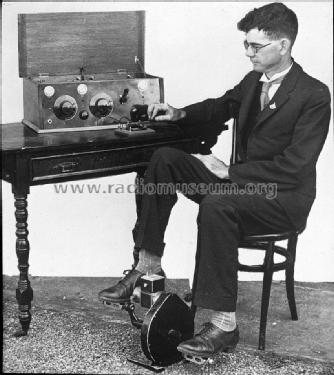Pedal Wireless Baby
Traeger Transceivers Pty. Ltd.; Adelaide
- País
- Australia
- Fabricante / Marca
- Traeger Transceivers Pty. Ltd.; Adelaide
- Año
- 1928
- Categoría
- Transmisor-Receptor comercial (no de Radioaficionado)
- Radiomuseum.org ID
- 275691
- Numero de valvulas
- 3
- Principio principal
- RFS (Radio Frecuencia Sintonizada) en general
- Gama de ondas
- OM y OC
- Tensión de funcionamiento
- Pilas + jack (etc.) para alimentación externa. / 2 × 1.5 & 9 or 180 Volt
- Altavoz
- - solamente tiene Auricular (mini) de oido
- Material
- Madera
- de Radiomuseum.org
- Modelo: Pedal Wireless Baby - Traeger Transceivers Pty. Ltd.
- Forma
- Sobremesa apaisado (tamaño grande).
- Anotaciones
-
Alf Taeger with help from Harry Kauper built the first Pedal Transceiver in 1928 and the first practical test took place in November. Six Pedal Wirelesses were built in 1929, for the Air Medical service, the predecessor to the Royal flying Doctor Service.
The transceiver used a B205 triode as a crystal oscillator, output stage with an RF output of 1.5 W.
It transmitted Morse code on a frequency of 2230 kHz. Morse was used because voice transmission was not practical at the time due to the higher power consumption required. Low power battery valves suitable for voice transmission did not become available till mid-1930’s.
The 2 valve regenerative receiver used two A141 tetrodes. The receiver covered the broadcast band up to approximately 4 MHz.
The filament supply was from two 1.5 V dry batteries and one 9 V battery. Treager developed a pedal generator to supply the B+ producing 180 V.
Silicon Chip magazine of November 2010 describes a replica of this radio built by John Sheard.
- Mencionado en
- Silicon Chip magazine, November 2010, Page 98
- Autor
- Modelo creado por Gary Cowans. Ver en "Modificar Ficha" los participantes posteriores.
- Otros modelos
-
Donde encontrará 6 modelos, 4 con imágenes y 1 con esquemas.
Ir al listado general de Traeger Transceivers Pty. Ltd.; Adelaide
Literatura
El modelo Pedal Wireless está documentado en la siguiente literatura.

